What is the Hawk offense in basketball
The Hawk offense, also known as the Hawk set, is a unique basketball offensive strategy that utilizes high post action, a stack alignment, and various basketball screens to create scoring opportunities near the basket or near the perimeter for one or more players on the offensive team.
Also, the Hawk offense was initially developed by Coach Hubie Brown during his time as the head coach of the Atlanta Hawks NBA team in the mid-1970s, hence its name.
What are general advantages of implementing the Hawk offense
Provides flexibility
One noteworthy advantage of implementing the Hawk offense is that it provides much flexibility and can be used in a number of ways to produce the highest quality shots for one or more of the offensive team’s best players.
For example, the Hawk offense can be executed by teams that want to create a open perimeter jump shot for their best shooter or it could be used by teams that prefer to play through their best low post players.
Moreover, if a team has a point guard or shooting guard with low post scoring abilities and if those same players are bigger and/or have more strength than their respective defensive match-ups, then the the Hawk offense could be applied to generate scoring options, particularly near the basket.
Typically includes all five players
One other notable advantage of the Hawk offense is that it typically includes all five players most (if not all) of the time.
This basically means that each player will potentially have the opportunity to contribute to the team’s overall success, regardless if a player only did something as simple as setting a good basketball screen for another teammate or passing the ball to another teammate who afterwards, took an open jump shot.
What is a general disadvantage of implementing the Hawk offense
One particular disadvantage of implementing the Hawk offense is that because it begins with a dribble entry towards a side of the floor, the offensive team would need to have a good point guard (or any other offensive player that initiates the offense) with above average dribbling skills that can handle potential defensive pressure near the top during the initiation of the Hawk set.
In other words, if the point guard (or another player with the ball) receives defensive pressure at the top upon entering into the frontcourt but that same offensive player possesses less than average dribbling skills, it would most likely be challenging to initiate the offense, particularly near the wing area.
However, it should also be noted that defensive pressure, especially against the offensive player in possession of the ball during the initial phase, could be mitigated to one degree or another with pressure release counters.
What is an example of the initial formation for the Hawk offense
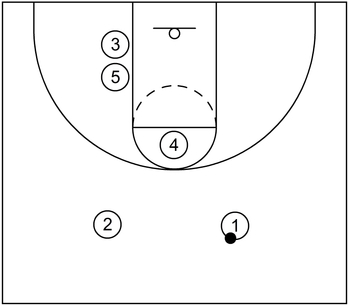
This is an example of the initial formation for the Hawk offense. It begins with two players, usually the point guard and shooting guard, in the slot areas of the court.
Additionally, there are two offensive players, generally a small forward and a center, aligned in a stack near the low post area opposite the ball. Furthermore, there is also another player, typically a power forward, set up near the high post area.
What is an example of a basic option within the Hawk offense
Basic – Part 1
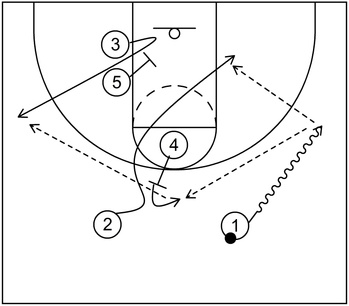
This is an example of the primary basic option within the Hawk offense. To start, 1 executes a dribble entry towards the right side wing area. Following that, 2 cuts to the right side low post block via the back screen set by 4.
After that, 2 could receive the ball from 1 and score near the basket with a low post move. If that is not available, then 4 could pop out to the top after setting the screen and then receive the ball from 1.
Also, as that happens, 3 could cut to the left side wing via the down screen set by 5.
Following that, 3 could receive the ball from 4 and then take the three-point jump shot if that is open.
Basic – Part 2
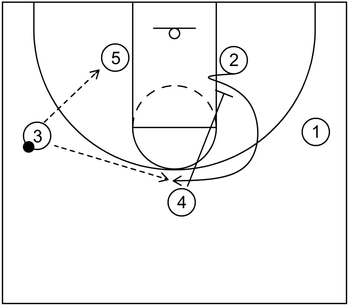
If 3 is not open, then 5 could establish position near the left side low post block and receive the ball from 3. Afterwards, 5 could score with a low post move.
Additionally, as an alternative option, 2 could cut to the top via the down screen set by 4 and receive the ball from 3.
From there, 2 could take the jump shot if open while 4 and 5 attempt to gather an offensive rebound if 2 happens to miss the jump shot.
What is an example of a screen the screener option within the Hawk offense
Screen the Screener – Part 1
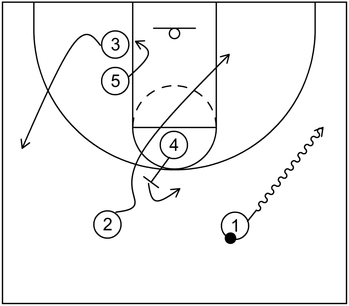
This is an example of a screen the screener option within the Hawk offense which is essentially a wrinkle to the primary basic set.
To start, 1 executes a dribble entry towards the right side wing area. As that occurs, 2 cuts to the right side low post block via the screen set by 4.
Also, as that happens, 4 pops to the top while 3 cuts to the left side wing and 5 fills the vacated area near the left side low post block.
Screen the Screener – Part 2
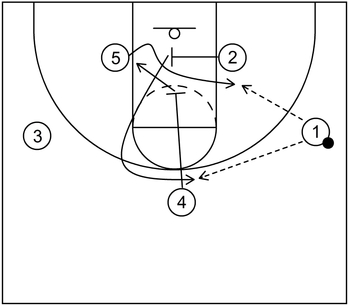
Next, 5 cuts across the lane to the right side low post block via the cross screen set by 2. Immediately afterwards, 2 cuts to the top via the down screen set by 4.
From that point, 5 could receive the ball from 1 and score near the rim with a low post move.
Alternatively, 2 could receive the ball from 1 and take the three-point shot if open while 4 and 5 attempt to offensive rebound the possible missed shot.
However, if 2 does not take the jump shot, then 4 could fill the left side low post block.
Screen the Screener – Part 3
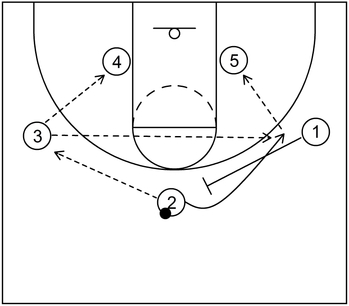
After that, 3 could receive the ball from 2 and then, 4 could receive the ball from 3. Following that, 4 could score near the basket with a low post move.
Nonetheless, if 4 does not receive the ball from 3, then 2 could cut to the right side wing via a flare screen set by 1. Afterwards, 2 could receive the ball from 3 via a skip pass and take the open jump shot.
Moreover, if 2 does not take the jump shot, then 5 could receive the ball from 2 and score near the rim with a low post move.
Affiliate Disclosure: I may earn a commission on qualifying purchases made through the links below.
What is an example of a pick and roll option within the Hawk offense
Pick and Roll – Part 1
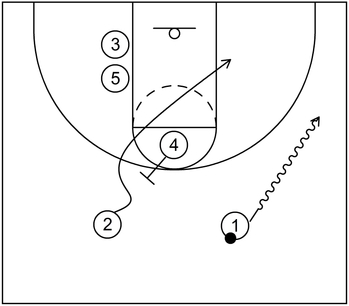
This is an example of a pick and roll option within the Hawk offense derived from Hubie Brown’s Hawk Offense with Lason Perkins.
To begin, 1 dribbles toward the right side wing while 2 cuts to the right side low post block via the back screen set by 4 in the high post.
Pick and Roll – Part 2
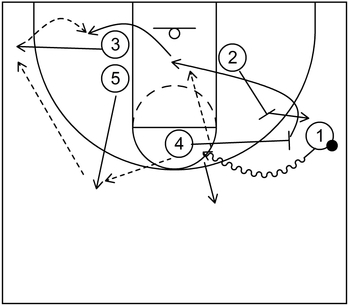
Next, 1 dribbles toward the middle of the court, particularly near the high post via the pick set by 4. Following that, 4 rolls to the basket via a back screen set by 2 while 5 lifts to the left slot area and 3 pops out to the left side corner.
Afterwards, 4 could receive the ball from 1 and score near the basket. On the other hand, if 4 does not receive the ball, then 5 could receive the ball from 1 and then 3 could receive the ball from 5.
From that point, 4 could continue the cut through to the left side low post block, receive the ball from 3, and then score near the rim with a low post move.
What is an example of a pick and pop option within the Hawk offense
Pick and Pop – Part 1
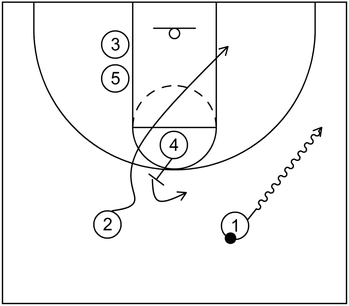
This is an example of a pick and pop option within the Hawk offense. To start, 1 executes a dribble entry towards the right side wing.
Afterwards, 2 cuts to the right side low post block via the back screen set by 4. Also, 4 moves out toward the top after setting the back screen action.
Pick and Pop – Part 2
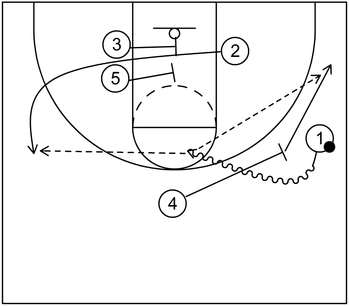
Next, 1 dribbles toward the middle of the court, particularly near the high post area via the on-ball screen set by 4.
As that occurs, 2 cuts to the left side wing area by way of an elevator screen set by 3 and 5.
Additionally, at the same time, 4 pops out towards the right side corner after setting the on-ball screen.
Following that, 2 could receive the ball from 1 and take the open jump shot. Moreover, as a secondary option, 4 could receive the ball from 1 and take the open shot as well.
What are examples of pressure release counters for the Hawk offense
These are examples of pressure release counters that could be implemented if the player with the ball receives an excessive amount of defensive pressure before the offense gets initiated.
Pressure Release – Example 1
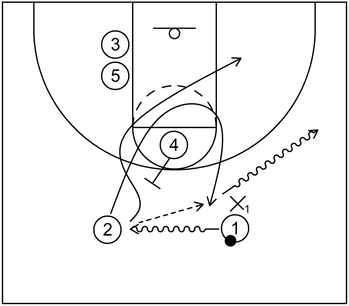
This example utilizes a shallow cut to release or mitigate the defensive pressure. To begin, 1 dribbles toward 2 at the left slot area as a counter to the pressure defense of X1.
When that occurs, 2 executes a shallow cut to the right slot area and receives the ball from 1. Afterwards, 2 can initiate the offense by dribbling towards the right side wing area while 1 cuts to the right side low post block.
Pressure Release – Example 2
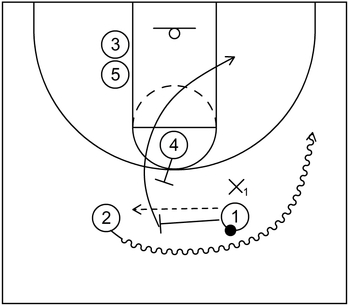
This example uses the pass and follow offensive tactic to release or limit the defensive pressure. To start, 2 receives the ball from 1 as a counter to the pressure defense of X1.
Next, 2 initiates the offense by dribbling to the right side wing via the on-ball screen set by 1 who followed the initial pass. From there, 1 cuts to the right side low post block via the back screen set by 4.
Pressure Release – Example 3
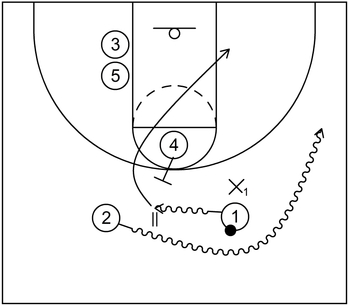
This example features dribble handoff action as a release to defensive pressure near the top. To demonstrate, 1 executes a dribble handoff with 2 as a counter to the pressure defense of X1.
Afterwards, 2 initiates the offense by dribbling to the right side wing area. Following that, 1 cuts to the right side low post block by way of the back screen set by 4.
What are examples of half court sets comparable to the Hawk offense
The 1-4 high offense is a basketball offensive strategy that primarily utilizes the high post as well as the wing areas to create scoring opportunities near the basket or from the perimeter, typically with a variety of basketball cuts and/or basketball screens.
The box offense is a basketball offensive strategy that utilizes a variety of off-ball and on-ball screens to create scoring opportunities, particularly for the team’s best scorers.
The Horns offense is a basketball offensive strategy which emphasizes spacing to create scoring opportunities near the basket or from the perimeter by way of various actions such as basketball screens and dribble handoffs.